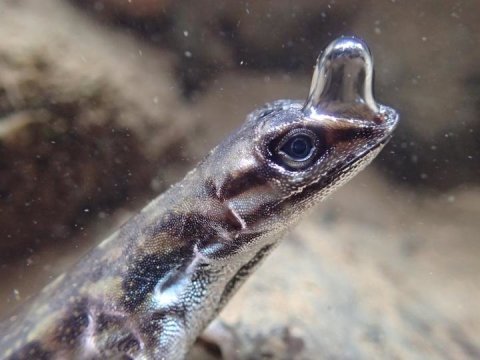[ad_1]
A Costa-Rican lizard species may have evolved scuba-diving qualities allowing it to stay underwater for 16 minutes, according to faculty at Binghamton University, State University of New York.
Lindsey Swierk, assistant research professor of biological sciences, documented that the water anole (Anolis aquaticus) is able to breathe under water for long periods of time to escape from predators. It appears that the species may have formed an underwater respiration system consisting of a recycled air bubble that clings to the anole’s head.
“Diving under water and remaining there for a long time is an anti-predator strategy for water anoles,” said Swierk. “These lizards aren’t particularly speedy, and taking to the water is a very effective option. (Take it from a biologist who sometimes struggles to capture her study organism because they’re so good at diving.) It’s easy to ‘disappear’ to a predator’s eye once you hide under water for a few minutes. I think that any underwater breathing adaptations in water anoles would have arisen to extend the amount of time they can stay in their underwater refuge.”
The unique behavior was documented for the first time by Swierk in a video that shows the anole breathing out and re-inhaling an air pocket under water. Swierk first noticed this species when she was walking along the mountain streams in Costa Rica and observed the lizards dive under water and stay submerged for a long period of time. Further analysis of the lizards’ stomachs uncovered that they eat some insects that are mainly found under water, hinting that the species may dive under water for reasons other than just avoiding predators.
“Finding evidence suggesting that water anoles ‘breathe’ under water was serendipitous, and not part of my original research plan,” said Swierk. “I was impressed and pretty confused about the length of the dive, which gave me an itch to take a closer look with an underwater camera in the next couple of years. That’s when I saw that the anoles appeared to be rebreathing a bubble of air that covered their heads.”
Swierk said she believes the lizard might be extracting oxygen from these bubbles.
“I think it’s possible that some additional air pockets are being trapped around the anole’s head and throat, and that the inhalation and exhalation of the air bubble allow for some trading of fresh air among these air pockets, allowing the anole to swap air in its current air bubble with ‘new’ air,” said Swierk. “It’s additionally possible that the air bubble plays a role in allowing an anole to get rid of carbon dioxide. I suspect that there might be morphological adaptations, namely the shape of the top of the anole’s head, which allows a large bubble of air to cling to it easily.”
Swierk’s lab plans to conduct several types of follow-up research on the “bubble-breathing” observation, hoping to tackle questions related to the antipredator function of the air bubble breathing in the field, how anole head shape influences bubble formation and the physiology underlying this potential adaptation.
“If future investigation reveals that this rebreathing behavior is adaptive, then I would imagine that it is a trait that evolved over time to allow water anoles, and perhaps similar anole species, to thrive in their aquatic habitats,” said Swierk.
This research is supported by a grant from the National Science Foundation.
The observation was published in Herpetological Review.
Story Source:
Materials provided by Binghamton University. Note: Content may be edited for style and length.
[ad_2]















